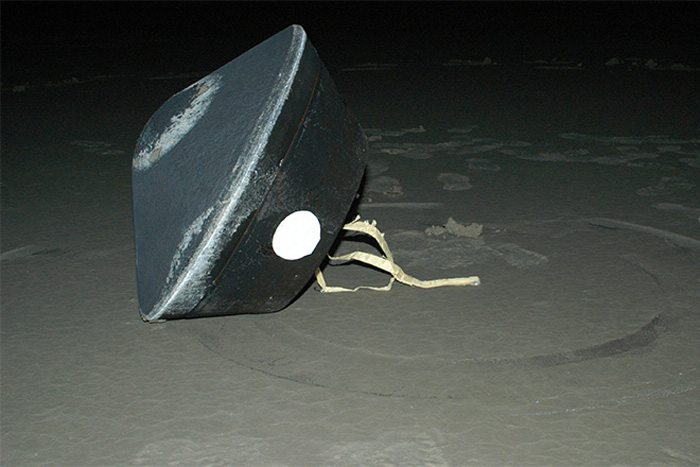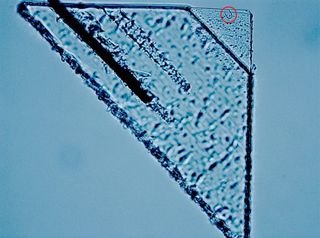Stardust Brought Back Comet Pieces 10 Years Ago

On a January morning 10 years ago, tiny pieces of a comet landed on Earth inside of a spacecraft. NASA's Stardust return-sample capsule arrived in Utah with its precious cargo on board, and ever since, principal investigator Don Brownlee (University of Washington) has been combing through the samples to see what it collected after seven years in space.
PHOTOS: This is Why Some Asteroids Act Like Comets
Even years later, surprises have emerged. In 2014, Brownlee's team announced that probable interstellar particle tracks were found in the aerogel and aluminum foil particle detectors. A newer paper (by another team) submitted to the Lunar and Planetary Science Conference in Houston suggests this interplanetary dust is also made up in part of glass, which is a rare element in meteoroids.
"We're constantly learning new things using better and better techniques," Brownlee told Discovery News. "The more you look at these, how to deal with them, the more you can refine the techniques."
Stardust collected samples from Comet Wild-2 in 2004, about two years before a part of the spacecraft came back to Earth with samples on board. The spacecraft was a pioneer in sample collection, with only one spacecraft (Japan's Hayabusa, in 2010) doing it since on an asteroid. Hayabusa-2 (in flight now) and NASA's OSIRIS-REx (yet to be launched) plan asteroid sample returns in the coming years.
NEWS: Interstellar Dust Discovered Inside NASA Spacecraft

One of the biggest surprises of the mission, Brownlee recalled, was finding that at least half the rocky material in the comet was made of materials that were "white-hot" when they were formed. This suggested that the rocky stuff was almost all formed in closer to the sun, and then transported out to the region where Pluto was, where ices formed. It gave a new understanding of our solar system's history.
Get the Space.com Newsletter
Breaking space news, the latest updates on rocket launches, skywatching events and more!
Another comet mission has been on the mind of the public lately. The European Rosetta mission has been orbiting Comet 67P/Churyumov–Gerasimenko for more than a year, and delivered a lander (Philae) that worked for a few days on the surface. Brownlee said he was sad Philae didn't function for as long as planned, because that was the best way to do direct comparison with Stardust's findings. But Rosetta's gas analysis of 67P is "complementary" to the solids that Stardust brought back to Earth for analysis, he added.
PHOTOS: Rosetta's Comet Gets its Day in the Sun
"Rosetta is a fabulous mission," Brownlee said. "It tells you a lot about the structure and evolution of the comet. But from our perspective, it doesn't tell you much about the origins of the comet."
Besides his Stardust work, Brownlee is working on mission studies for doing a sample return mission from Enceladus — a geyser-spouting icy moon of Saturn — and a second comet-sample mission that would involve a landing.
Originally published on Discovery News.
Join our Space Forums to keep talking space on the latest missions, night sky and more! And if you have a news tip, correction or comment, let us know at: community@space.com.

Elizabeth Howell (she/her), Ph.D., is a staff writer in the spaceflight channel since 2022 covering diversity, education and gaming as well. She was contributing writer for Space.com for 10 years before joining full-time. Elizabeth's reporting includes multiple exclusives with the White House and Office of the Vice-President of the United States, an exclusive conversation with aspiring space tourist (and NSYNC bassist) Lance Bass, speaking several times with the International Space Station, witnessing five human spaceflight launches on two continents, flying parabolic, working inside a spacesuit, and participating in a simulated Mars mission. Her latest book, "Why Am I Taller?", is co-written with astronaut Dave Williams. Elizabeth holds a Ph.D. and M.Sc. in Space Studies from the University of North Dakota, a Bachelor of Journalism from Canada's Carleton University and a Bachelor of History from Canada's Athabasca University. Elizabeth is also a post-secondary instructor in communications and science at several institutions since 2015; her experience includes developing and teaching an astronomy course at Canada's Algonquin College (with Indigenous content as well) to more than 1,000 students since 2020. Elizabeth first got interested in space after watching the movie Apollo 13 in 1996, and still wants to be an astronaut someday. Mastodon: https://qoto.org/@howellspace